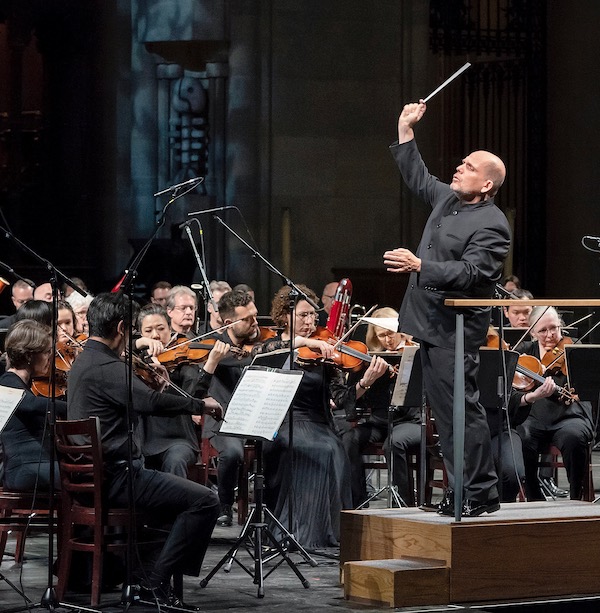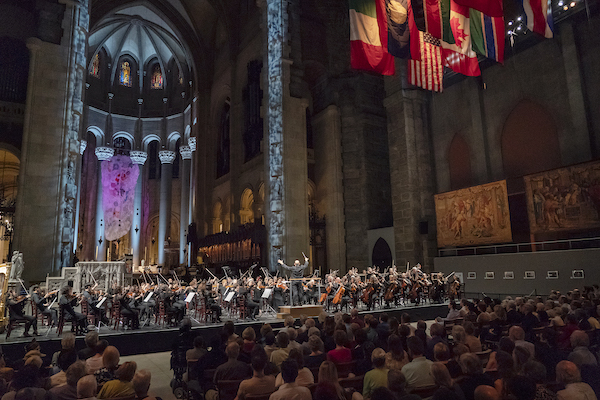Bruckner’s power and eloquence emerge through a challenging acoustic with van Zweden, Philharmonic

Jaap van Zweden conducted the New York Philharmonic in Bruckner’s Symphony No. 8 Monday night at the Cathedral of St. John the Divine. Photo: Jennifer Taylor
The music for this year’s New York Philharmonic’s free Memorial Day was well-chosen: Anton Bruckner’s Symphony No. 8. For a day meant to honor the war dead, Bruckner’s contemplation of life and the ecstasies and terrors of the afterlife offered a way to consider the ramifications of mortality that went far beyond what words could manage.
Bruckner’s unique sense of musical structure, its relationship to sacred architecture, and his sense of time that predates the invention of the mechanical clock were historically apt for the enormous gothic space of the Cathedral of St. John the Divine.
But the cathedral is possibly the most resonant enclosed space in New York City, alongside the atrium of the Metropolitan Museum of Art and the drill hall at the Park Avenue Armory. And so, as appropriate as the idea of Bruckner’s Eighth was for both the day and the site, music and venue were mismatched when it came to the actual musical performance.
What the Philharmonic musicians and conductor Jaap van Zweden were doing was not the issue, the space they were doing it in was. With a reflection of around five seconds, the Cathedral wrought all sorts of unwanted changes on the sound of the music. The space swallowed up enough of the sound of the orchestra that even though they may have been two dozen feet from the audience, the ears said they were far in the distance.
The reverb also covered the ensemble in thick, smooth velvet which flattered individual sections and instruments—the strings sounded ridiculously lush, the double-reeds extra piquant—but also acted as an emulsifier. It softened every possible edge and wreaked havoc with rhythms—one could see the orchestra playing together in time, but different instruments have different types and timings to their attacks; the slightest differential was magnified by the reverb so that sound that was synchronized at the point of production was disorganized once it reached the ears.
Yet, despite the daunting acoustical challenge, the force of the performance came through the soup and fog. The transitions between light and dark were musically and emotionally fluid, and though the low brass could not make the floor of the Cathedral tremble as in a standard concert hall, the rounded power of their playing was prominent in the overall sound. Ther playing in the final movement, especially the opening stretches, was driving, and put forward a touch of the crackle that had earlier been swallowed up in the space.
The moments of crisis in the opening and final moments were intense, and the bounce and lilt of the Scherzo, with a crisp tempo from van Zweden, nearly overcame the acoustic. The massive resonance was an inherent obstacle to dynamic subtlety—the first movement was confined to a narrow range between mezzo-forte and forte, but the conductor and musicians found their way to a true piano in the scherzo, and from that point on the dynamics had a greater range and stronger expressive effect.
One surprise, and disappointment, was in the long Adagio movement, where the middle section frequently disappeared into a grey cloud of sound. This had a languorous effect, but one found solace in the Philharmonic’s playing of the heavenly cadences.
Jaap van Zweden leads the New York Philharmonic in Shostakovich’s Chamber Symphony and Beethoven’s Symphony No. 3, 7:30 p.m., Tuesday, and John Corigliano’s Symphony No. 1 starting 7:30 p.m. Thursday. nyphil.org

Photo: Jennifer Taylor